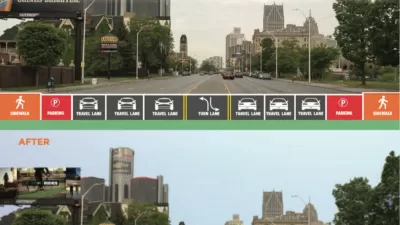Bike boxes, a European import, may not have received as much attention other novel bike facilities such as protected bike lanes, but they are spreading. Nashville's first bike box accompanies a road diet and buffered bike lanes.
"More than 20 cities have painted [bike boxes] at intersections, according to Nashville's Metro Public Works," writes Josh Brown of The Tennessean who accompanied a group of Nashville cyclists in late August to "test the city’s first bike box — a space at an intersection that allows cyclists to cut ahead of traffic and wait in their own specially designated area until the light turns green." [See image].
The boxes are growing in popularity across the country as communities search for ways to reduce accidents between cyclists and motorists and encourage more people to use bicycles to get around.
In fact, according to most studies [PDF], the majority of bike-motor vehicle collisions occur at intersections, so the importance of these boxes can not be overstated from a bike safety perspective.
“There’s a lot of misunderstanding for the rules of the road between bicyclers and motorists,” said Liz Thompson, executive director of Walk/Bike Nashville, a nonprofit that promotes cycling and walking as transportation alternatives. “When there’s a bike lane and bike box that gives you space up ahead, that in general that can reduce a lot of that tension.
The bike box is located on Church Street which has seen major, though controversial street improvements to make it significantly more bike-friendly.
The new box comes about a month after public works made changes to the Church Street bridge that reduced the number of traffic lanes from four to two with a center turning lane. The officials took the extra space to create buffered bicycle lanes on both sides of the street.
The Church Street road diet has come at a cost. Brown writes that auto congestion has increased significantly, and bike usage may not have increased. However, Nora Kern of Walk/Bike Nashville states that "as the population of the city grows, the streets around Nashville’s urban core won’t be able to accommodate a car for every person."
“We have to start now to start planning for the future of Nashville,” [Kern] said. “In five years, if we wait, it’s going to be 100 times harder.”
FULL STORY: New bike box offers cyclists their own spot in traffic

Planetizen Federal Action Tracker
A weekly monitor of how Trump’s orders and actions are impacting planners and planning in America.

Map: Where Senate Republicans Want to Sell Your Public Lands
For public land advocates, the Senate Republicans’ proposal to sell millions of acres of public land in the West is “the biggest fight of their careers.”

Restaurant Patios Were a Pandemic Win — Why Were They so Hard to Keep?
Social distancing requirements and changes in travel patterns prompted cities to pilot new uses for street and sidewalk space. Then it got complicated.

DC Area County Eliminates Bus Fares
Montgomery County joins a growing trend of making transit free.

Platform Pilsner: Vancouver Transit Agency Releases... a Beer?
TransLink will receive a portion of every sale of the four-pack.

Toronto Weighs Cheaper Transit, Parking Hikes for Major Events
Special event rates would take effect during large festivals, sports games and concerts to ‘discourage driving, manage congestion and free up space for transit.”
Urban Design for Planners 1: Software Tools
This six-course series explores essential urban design concepts using open source software and equips planners with the tools they need to participate fully in the urban design process.
Planning for Universal Design
Learn the tools for implementing Universal Design in planning regulations.
Heyer Gruel & Associates PA
JM Goldson LLC
Custer County Colorado
City of Camden Redevelopment Agency
City of Astoria
Transportation Research & Education Center (TREC) at Portland State University
Camden Redevelopment Agency
City of Claremont
Municipality of Princeton (NJ)





























